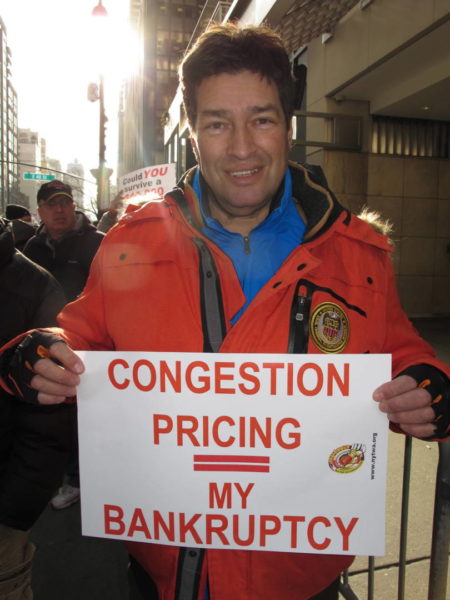NEW YORK, N.Y.—Uber is suing the City of New York in an effort to kill its limits on the number of app-based taxis allowed on the city’s streets.

The suit, filed in State Supreme Court Feb. 15, argues that the city’s one-year cap on new for-hire vehicle licenses, enacted last August, is illegal, on the grounds that state law does not authorize the city to enact such limits, and that the 80,000 Uber vehicles added to the city’s streets since 2013 are not causing the traffic congestion the limits are intended to reduce.
Section 181 of the state’s General Municipal Law, it contends, lets cities limit the number of taxis, but grants “no cities the power to limit the number of limousines and livery vehicles.” In 2015 and 2016, it adds, the state legislature did not approve a proposed amendment that would have let cities limit the number of livery vehicles—the legal category app-based taxis are regulated under.
The suit also claims that the City Council did not consider whether the cap “would have even the slightest efficacy in addressing congestion” in the Manhattan central business district, and enacted the cap “in the absence of any evidence that app-based FHVs are meaningfully contributing to it.” The proper strategy, it says, is the state’s one of imposing congestion-pricing surcharges on taxis and other for-hire vehicles and using the proceeds for mass transit, with plans to expand congestion pricing to all vehicles entering the central business district.
“No legal challenge changes the fact that Uber made congestion on our roads worse and paid their drivers less than a living wage,” responded mayoral spokesperson Seth Stein. “The city’s new laws aim to change that.”
Bhairavi Desai, head of the New York Taxi Workers Alliance, called the company’s logic absurd. “Uber is arguing that the congestion surcharge on taxis, something the company lobbied for, makes the cap unnecessary,” she said in a statement. “But Uber created this congestion. “The absurdity would be laughable if the consequences on drivers hadn’t been so tragic.”
Uber is arguing that the congestion surcharge on taxis, something the company lobbied for, makes the cap unnecessary. But Uber created this congestion. The absurdity would be laughable if the consequences on drivers hadn’t been so tragic. — Bhairavi Desai, head of the New York Taxi Workers Alliance
The Uber suit argues that by limiting the number of vehicles the company can put on the road, the city “chose to significantly restrict service, growth and competition by the for-hire vehicle industry,” and that will have a disproportionate effect on both “residents outside of Manhattan who have long been underserved by yellow taxis and mass transit” and “lower-income neighborhoods and areas with substantial minority populations.” Of the about 40 million trips Uber vehicles took in the second quarter of 2018, it says, 24 million both began and ended outside the Manhattan central business district.
The actual picture is more complex. According to data from the city Taxi and Limousine Commission, while 92% of yellow-cab trips begin in Manhattan, 53% of trips by “high volume FHVs”—the term the TLC uses to distinguish app-based taxis from black cabs and traditional car services—do. High volume FHVs averaged about 621,000 trips a day in the second quarter of 2018, while yellow cabs averaged about 300,000 a day—so, extrapolating from those figures, app-based cabs picked up more passengers in Manhattan during that period than yellow cabs did.
“It is too early to tell the impacts of the moratorium,” said a January TLC report on the cap’s first quarter sent to Council Speaker Corey Johnson in early January. However, it said that the number of average daily trips by the four main app-based companies—Uber, Lyft, Via, and Juno—had risen slightly in core Manhattan, the “inner ring” of upper Manhattan and the Brooklyn-Queens area from Park Slope to Astoria, the airports, and the rest of the city.
“We do not see an impact on ridership and do not recommend the issuance of any licenses for special geographic areas,” it concluded.
According to TLC data, the average number of trips by high-volume FHVs more than doubled from 2016 to 2018. In November 2017, there were about 46,000 vehicles a day making a total of 517,000 trips. In November 2018, there were about 56,900 vehicles making more than 690,000 trips.
That growth has come at the expense of other sectors of the industry. In November 2018, the most recent month for which there is TLC data available, there were an average of about 11,000 yellow cabs a day on the road, with 23,500 drivers making 271,500 trips. In November 2012, the number of yellow cabs averaged slightly more than 13,300 a day, with 31,700 drivers picking up 459,000 fares.
Meanwhile, the average daily number of trips by green cabs, introduced in 2013 to serve the outer boroughs, fell from 45,000 to 26,000, while traditional livery cabs—which pick up more than 80% of their fares in the four outer boroughs—declined from 108,000 to 80,000.
Uber, said Desai, “wants the right to add more and more cars to our streets without limit,” but “there is a very human cost” to that.
“Eight drivers have now died by suicide because of the crisis Uber created,” she said. “That’s why Uber drivers and yellow cab drivers from across the city united to win the historic cap on for-hire-vehicles—to put an end to the financial despair, debt, and poverty that is literally killing our brothers. With more than 80,000 Uber cars on our roads, no driver can get enough fares to feed our families.”

